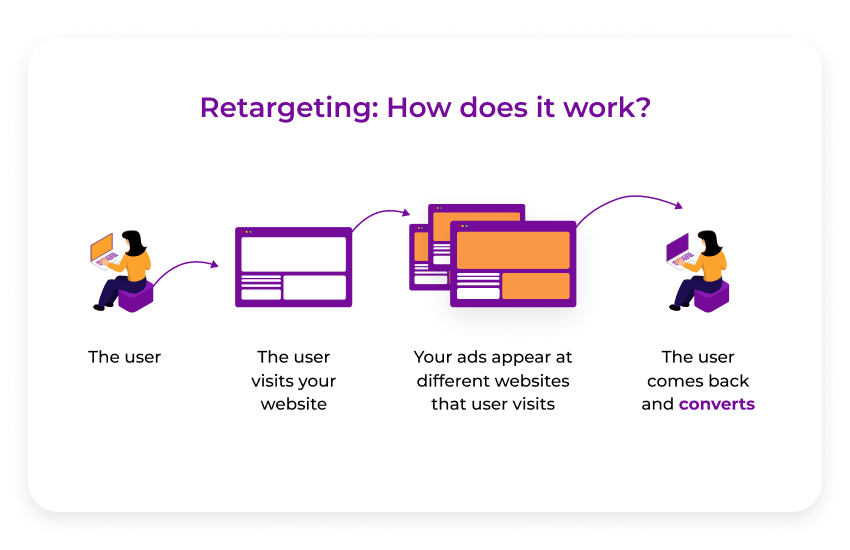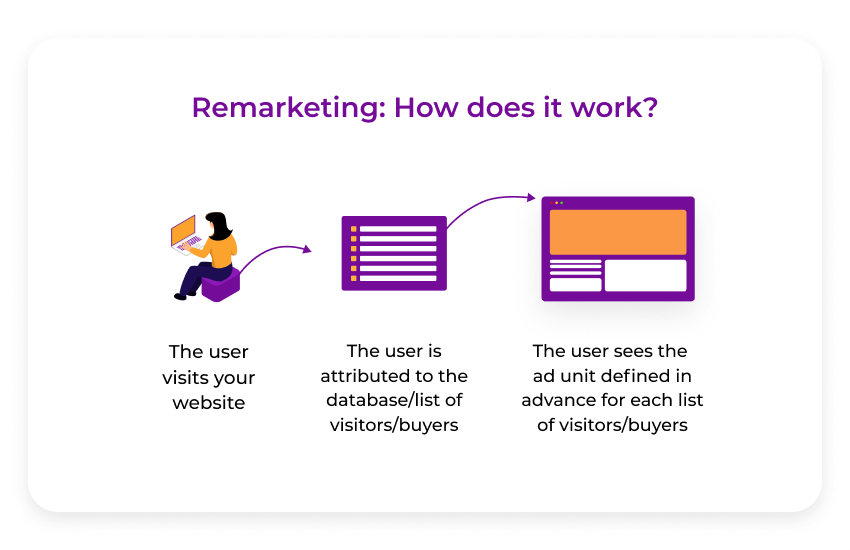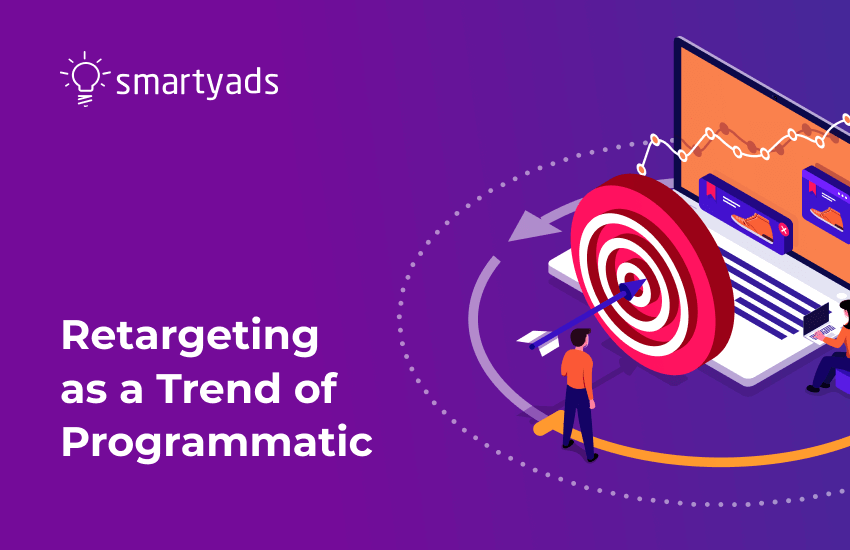Today, the way products and services are advertised to consumers is changing at a rapid pace. Various ad networks and digital marketers are trying to make their brands stand out in a competitive market. Thus, new tools that accelerate media advertising and enhance brand awareness are in huge demand. With Big Data making a giant splash, programmatic technologies have already become a widespread phenomenon in digital advertising, aiming to intensify the profitability and productivity of ad buying with the help of automated functionalities. Programmatic is used to prevent or overcome pitfalls that may occur in a digital marketer's lifecycle, as well as to make the process of automated ad purchasing more transparent and cost-effective. Programmatic solutions for desktop and mobile DSP ensure the delivery of highly personalized messages in real time. Let’s discover why.
What is retargeting? Introducing a new tool to a digital marketing toolkit
Brand managers make their ads relevant to the users in order to create a meaningful customer experience. According to the latest stats, 70% of marketers prefer to use retargeting to increase brand awareness, whereas 60% use it to tighten social engagement (spending 10–50% of their entire online ad budget on it). According to stats, retargeted shoppers are 70% more likely to convert. Retargeting campaigns can increase conversion up to 150%. Besides, today, lots of tech vendors offer full-stack solutions for advertisers and publishers. For that reason, retargeting is turning into something essential, something of great necessity in the future of digital marketing, and here is why.
Retargeting is an innovative tool for ad agencies and digital marketers to conduct their brand strategies in a way that allows them to enhance user targeting and reach the highest level of conversion. Retargeting ad spend focuses only on those who have been familiar with your brand or recently shown interest in your products or services. Thanks to such effectiveness, retargeting marketing helps to achieve a higher ROI as opposed to other digital tactics. In other words, retargeted ads are repeatedly displayed to visitors after they leave your website. They have proven to be a powerful tool to convert bounced traffic into potential consumers. In turn, there’s a good chance that users will complete your call to action – they might want to return back to your website, finish a purchase, or use any service your brand offers.
How do retargeting ads work?
Before you decide to make retargeting a part of your robust content strategy, let’s dive a bit deeper into the workflow. Retargeting is a cookie-based technology with a piece of javascript code in-built on a website. Once a new visitor comes, that piece of code drops an unnoticeable browser cookie to let a special retargeting marker know at what time these ads should be placed on a website. To be specific, retargeted ads are “chasing” the prior website users on whatever web pages or web devices they are in (as well as on social media platforms). Retargeting ads remind people of your products or services, no matter where they are. Hence, the chances of revisiting your website are increased.
However, there are several effective types of retargeting marketing, which could be displayed to users in more than one form. For example, on other webpages after leaving your website, as Facebook ads, they might be shown to new users who were recently searching for keywords somehow related to your business expertise (which is called “search retargeting”). Besides, your ads could be demonstrated in the email newsletters.

What is the difference between retargeting and remarketing?
While retargeting is commonly based on cookies, remarketing is used to collect users’ data for targeting them with personalized campaigns through email marketing. One of the reasons why email campaigns work is that this type of communication channel remains one of the most effective to engage better with customers. Well, how does remarketing work? Once the user has visited a website, they’re automatically added to what is called a “remarketing list.” Then, personalized ad campaigns are created specifically for people on that list. So, the ads are shown only to potential consumers.

Even though retargeting and remarketing differ from each other, they are sticking to a single goal – to make visitors want to return to your website. However, they both will be working better in tandem – as a powerful tactic to re-engage visitors. However, decide beforehand which one should be prioritized.
Why it's worth turning to retargeting: key benefits
Increased user awareness
After leaving your website, people will remember your brand better through enhanced visibility. Users are constantly noticing retargeted ads that are shown to them in an increased amount of time. The result? Your brand becomes memorable.
Cost-effectiveness
Retargeted marketing has proven to be a cost-effective tool that converts only those who were interested in your products or services earlier. These ads are tightly focused on consumers who are ready to take action on your website. Hence, you won’t spend ad money on worthless digital campaigns. The result? More purchases.
Long-term campaigns
Ad networks and advertisers can gather more insights when remarketing campaigns are running long-term. In such a way, your brand is recognizable, the costs are saved, and the profits are growing. All that’s left is to continue opening up new interesting prospects. The result? Increased conversions.
Some of the best practices of retargeting marketing
Before you get started with retargeting, follow these principles to run a smarter campaign.
-
Exclude those who are already converted.
In doing so, you won’t disturb people who are already familiar with your brand or have taken any action on a website. That means your time and efforts are saved!
-
Use a frequency cap.
In order to make sense of your ad campaigns, try to limit the amount of time your ads are shown all over the web and be strategic in ads planning and scheduling. That means your customers are no longer overwhelmed with an enormous amount of ads.
-
Ensure contextual targeting
Consider all contextual factors, such as age, gender, demographic information, and other essential data. Such an algorithm will help digital marketers to determine what types of ads their consumers are interested in and serve them accordingly. That means you will be placing your ads at the right time and to the right people.
-
Select one person to run retargeting campaigns.
In order to figure out which campaigns are working better than the others, choose one specific marketer who will be responsible for running retargeting campaigns. It will be far more beneficial in terms of analyzing its ups and downs.
That means more advanced analytics for future campaigns
-
Optimize banner ads
Never underestimate the power of banner ads that you can run on the demand-side platform. The amount of content you place on ads matters. There should be a wise correlation between the space and the information on it. Moreover, take into consideration the colors, design, and how clickable your call-to-action buttons are. Also, make your creatives as lightweight as possible to facilitate smooth unit rendering on the ad server. All these aspects determine whether your ads will drive success. That means your ads are easy to read and well-branded.
It’s time to forget about manual ad placing
Even if your ad campaigns are perfectly designed, they have to be shown to the target audience in real time and function in accordance with your business objectives. One of the most effective ways to increase your conversion rates is to find a tool that meets your specific brand needs. The whole programmatic ecosystem consists of demand-side platforms (DSPs), supply-side platforms (SSPs), ad exchanges, etc. The top Demand-side platforms offer unique, cutting-edge tech solutions to build comprehensive retargeting marketing campaigns, engage more consumers, and attain a higher ROI. DPSs like SmartyAds allow forecasting of which impression to bid on and help determine its value. Our Demand-side platform provides media-buying capabilities to multiple advertisers and ad networks to easily transform a brand story into an ad creative campaign across various channels and devices with DSP retargeting feature.
Don’t miss out on a chance to make your ad publishing process easier and more effective – with less ad spend yet much value due to the automated superpowers that SmartyAds DSP provides. To find out more about our innovative solutions, contact our digital experts!




